Building and Construction: Sustainability in Construction Projects
VerifiedAdded on 2021/04/17
|7
|2846
|368
Report
AI Summary
This report delves into the implications of sustainability within the construction sector, addressing challenges like insufficient knowledge and the need for sustainable design principles. It explores key aspects such as integrity, community involvement, precautionary behavior, and continual improvement. The report examines building materials, emphasizing the importance of climate suitability, ease of handling, and minimal waste. It also outlines various construction techniques, including prefabrication, waste management, and site environmental improvement. Furthermore, the report highlights water and energy efficiency, advocating for renewable energy sources like solar, wind, hydro, and geothermal power, alongside bioenergy and cogeneration. The paper emphasizes the importance of material selection, and the need for training and policy compliance in adopting new equipment. The report also discusses the importance of water and energy efficiency, and the use of daylighting in sustainable housing projects.
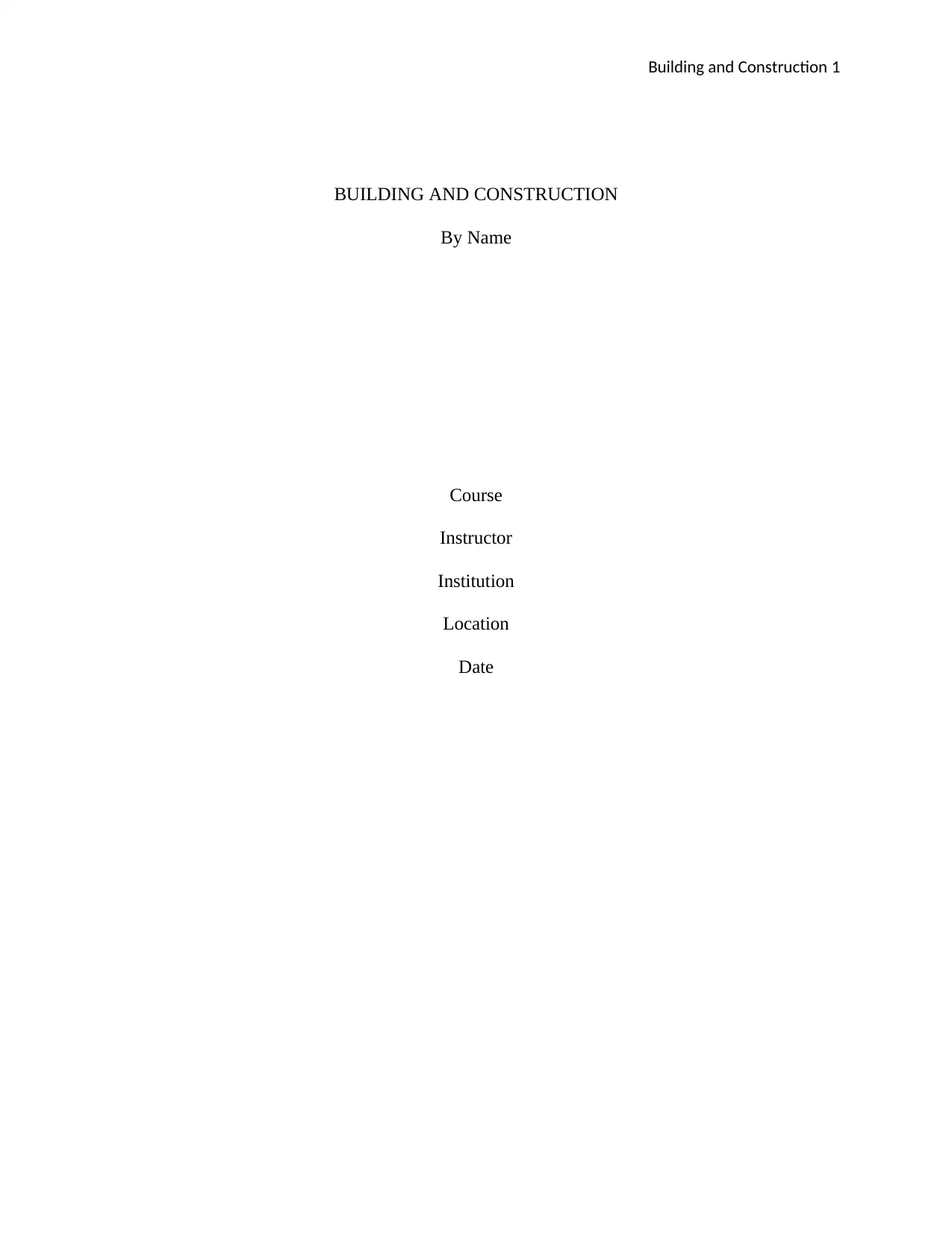
Building and Construction 1
BUILDING AND CONSTRUCTION
By Name
Course
Instructor
Institution
Location
Date
BUILDING AND CONSTRUCTION
By Name
Course
Instructor
Institution
Location
Date
Paraphrase This Document
Need a fresh take? Get an instant paraphrase of this document with our AI Paraphraser
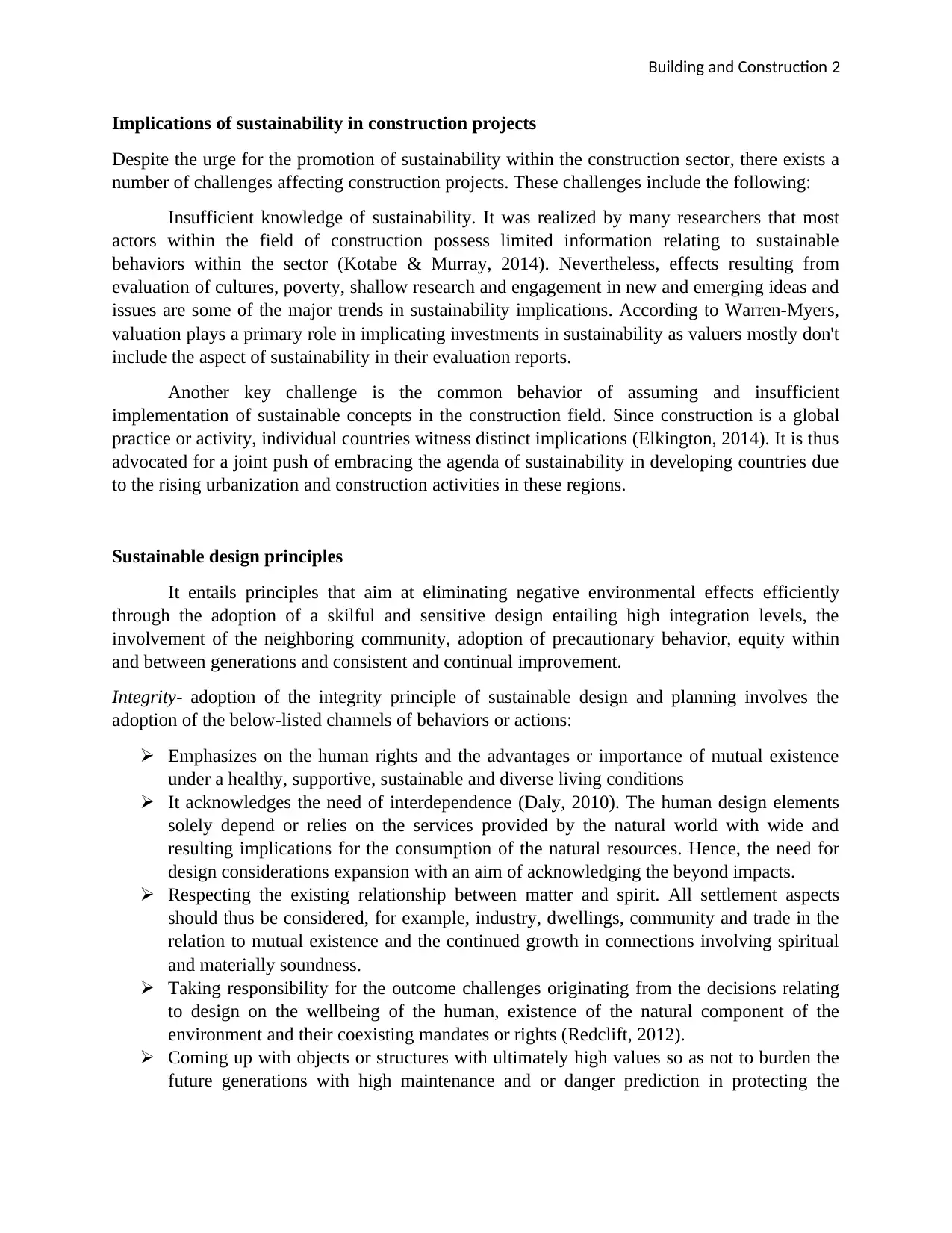
Building and Construction 2
Implications of sustainability in construction projects
Despite the urge for the promotion of sustainability within the construction sector, there exists a
number of challenges affecting construction projects. These challenges include the following:
Insufficient knowledge of sustainability. It was realized by many researchers that most
actors within the field of construction possess limited information relating to sustainable
behaviors within the sector (Kotabe & Murray, 2014). Nevertheless, effects resulting from
evaluation of cultures, poverty, shallow research and engagement in new and emerging ideas and
issues are some of the major trends in sustainability implications. According to Warren-Myers,
valuation plays a primary role in implicating investments in sustainability as valuers mostly don't
include the aspect of sustainability in their evaluation reports.
Another key challenge is the common behavior of assuming and insufficient
implementation of sustainable concepts in the construction field. Since construction is a global
practice or activity, individual countries witness distinct implications (Elkington, 2014). It is thus
advocated for a joint push of embracing the agenda of sustainability in developing countries due
to the rising urbanization and construction activities in these regions.
Sustainable design principles
It entails principles that aim at eliminating negative environmental effects efficiently
through the adoption of a skilful and sensitive design entailing high integration levels, the
involvement of the neighboring community, adoption of precautionary behavior, equity within
and between generations and consistent and continual improvement.
Integrity- adoption of the integrity principle of sustainable design and planning involves the
adoption of the below-listed channels of behaviors or actions:
Emphasizes on the human rights and the advantages or importance of mutual existence
under a healthy, supportive, sustainable and diverse living conditions
It acknowledges the need of interdependence (Daly, 2010). The human design elements
solely depend or relies on the services provided by the natural world with wide and
resulting implications for the consumption of the natural resources. Hence, the need for
design considerations expansion with an aim of acknowledging the beyond impacts.
Respecting the existing relationship between matter and spirit. All settlement aspects
should thus be considered, for example, industry, dwellings, community and trade in the
relation to mutual existence and the continued growth in connections involving spiritual
and materially soundness.
Taking responsibility for the outcome challenges originating from the decisions relating
to design on the wellbeing of the human, existence of the natural component of the
environment and their coexisting mandates or rights (Redclift, 2012).
Coming up with objects or structures with ultimately high values so as not to burden the
future generations with high maintenance and or danger prediction in protecting the
Implications of sustainability in construction projects
Despite the urge for the promotion of sustainability within the construction sector, there exists a
number of challenges affecting construction projects. These challenges include the following:
Insufficient knowledge of sustainability. It was realized by many researchers that most
actors within the field of construction possess limited information relating to sustainable
behaviors within the sector (Kotabe & Murray, 2014). Nevertheless, effects resulting from
evaluation of cultures, poverty, shallow research and engagement in new and emerging ideas and
issues are some of the major trends in sustainability implications. According to Warren-Myers,
valuation plays a primary role in implicating investments in sustainability as valuers mostly don't
include the aspect of sustainability in their evaluation reports.
Another key challenge is the common behavior of assuming and insufficient
implementation of sustainable concepts in the construction field. Since construction is a global
practice or activity, individual countries witness distinct implications (Elkington, 2014). It is thus
advocated for a joint push of embracing the agenda of sustainability in developing countries due
to the rising urbanization and construction activities in these regions.
Sustainable design principles
It entails principles that aim at eliminating negative environmental effects efficiently
through the adoption of a skilful and sensitive design entailing high integration levels, the
involvement of the neighboring community, adoption of precautionary behavior, equity within
and between generations and consistent and continual improvement.
Integrity- adoption of the integrity principle of sustainable design and planning involves the
adoption of the below-listed channels of behaviors or actions:
Emphasizes on the human rights and the advantages or importance of mutual existence
under a healthy, supportive, sustainable and diverse living conditions
It acknowledges the need of interdependence (Daly, 2010). The human design elements
solely depend or relies on the services provided by the natural world with wide and
resulting implications for the consumption of the natural resources. Hence, the need for
design considerations expansion with an aim of acknowledging the beyond impacts.
Respecting the existing relationship between matter and spirit. All settlement aspects
should thus be considered, for example, industry, dwellings, community and trade in the
relation to mutual existence and the continued growth in connections involving spiritual
and materially soundness.
Taking responsibility for the outcome challenges originating from the decisions relating
to design on the wellbeing of the human, existence of the natural component of the
environment and their coexisting mandates or rights (Redclift, 2012).
Coming up with objects or structures with ultimately high values so as not to burden the
future generations with high maintenance and or danger prediction in protecting the
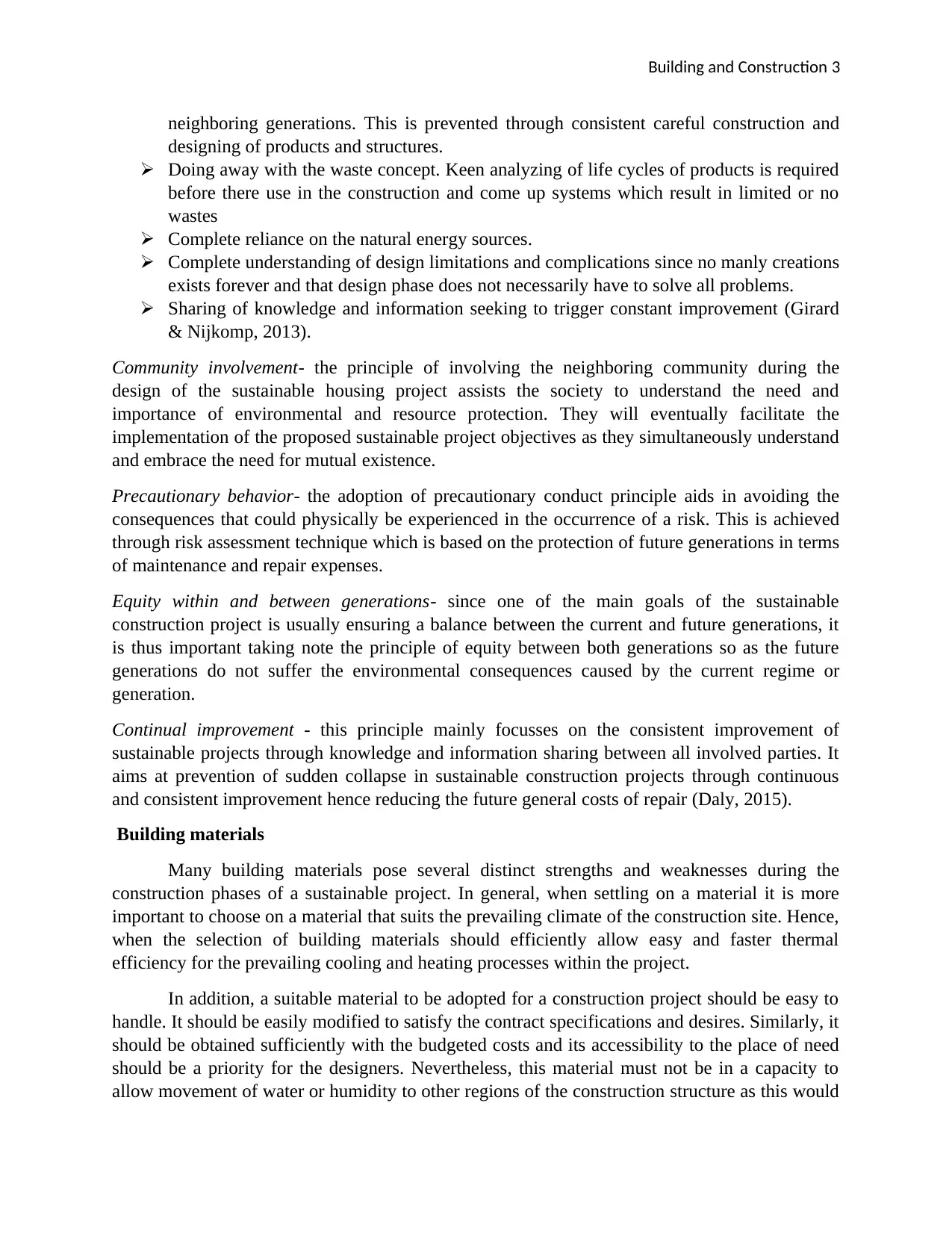
Building and Construction 3
neighboring generations. This is prevented through consistent careful construction and
designing of products and structures.
Doing away with the waste concept. Keen analyzing of life cycles of products is required
before there use in the construction and come up systems which result in limited or no
wastes
Complete reliance on the natural energy sources.
Complete understanding of design limitations and complications since no manly creations
exists forever and that design phase does not necessarily have to solve all problems.
Sharing of knowledge and information seeking to trigger constant improvement (Girard
& Nijkomp, 2013).
Community involvement- the principle of involving the neighboring community during the
design of the sustainable housing project assists the society to understand the need and
importance of environmental and resource protection. They will eventually facilitate the
implementation of the proposed sustainable project objectives as they simultaneously understand
and embrace the need for mutual existence.
Precautionary behavior- the adoption of precautionary conduct principle aids in avoiding the
consequences that could physically be experienced in the occurrence of a risk. This is achieved
through risk assessment technique which is based on the protection of future generations in terms
of maintenance and repair expenses.
Equity within and between generations- since one of the main goals of the sustainable
construction project is usually ensuring a balance between the current and future generations, it
is thus important taking note the principle of equity between both generations so as the future
generations do not suffer the environmental consequences caused by the current regime or
generation.
Continual improvement - this principle mainly focusses on the consistent improvement of
sustainable projects through knowledge and information sharing between all involved parties. It
aims at prevention of sudden collapse in sustainable construction projects through continuous
and consistent improvement hence reducing the future general costs of repair (Daly, 2015).
Building materials
Many building materials pose several distinct strengths and weaknesses during the
construction phases of a sustainable project. In general, when settling on a material it is more
important to choose on a material that suits the prevailing climate of the construction site. Hence,
when the selection of building materials should efficiently allow easy and faster thermal
efficiency for the prevailing cooling and heating processes within the project.
In addition, a suitable material to be adopted for a construction project should be easy to
handle. It should be easily modified to satisfy the contract specifications and desires. Similarly, it
should be obtained sufficiently with the budgeted costs and its accessibility to the place of need
should be a priority for the designers. Nevertheless, this material must not be in a capacity to
allow movement of water or humidity to other regions of the construction structure as this would
neighboring generations. This is prevented through consistent careful construction and
designing of products and structures.
Doing away with the waste concept. Keen analyzing of life cycles of products is required
before there use in the construction and come up systems which result in limited or no
wastes
Complete reliance on the natural energy sources.
Complete understanding of design limitations and complications since no manly creations
exists forever and that design phase does not necessarily have to solve all problems.
Sharing of knowledge and information seeking to trigger constant improvement (Girard
& Nijkomp, 2013).
Community involvement- the principle of involving the neighboring community during the
design of the sustainable housing project assists the society to understand the need and
importance of environmental and resource protection. They will eventually facilitate the
implementation of the proposed sustainable project objectives as they simultaneously understand
and embrace the need for mutual existence.
Precautionary behavior- the adoption of precautionary conduct principle aids in avoiding the
consequences that could physically be experienced in the occurrence of a risk. This is achieved
through risk assessment technique which is based on the protection of future generations in terms
of maintenance and repair expenses.
Equity within and between generations- since one of the main goals of the sustainable
construction project is usually ensuring a balance between the current and future generations, it
is thus important taking note the principle of equity between both generations so as the future
generations do not suffer the environmental consequences caused by the current regime or
generation.
Continual improvement - this principle mainly focusses on the consistent improvement of
sustainable projects through knowledge and information sharing between all involved parties. It
aims at prevention of sudden collapse in sustainable construction projects through continuous
and consistent improvement hence reducing the future general costs of repair (Daly, 2015).
Building materials
Many building materials pose several distinct strengths and weaknesses during the
construction phases of a sustainable project. In general, when settling on a material it is more
important to choose on a material that suits the prevailing climate of the construction site. Hence,
when the selection of building materials should efficiently allow easy and faster thermal
efficiency for the prevailing cooling and heating processes within the project.
In addition, a suitable material to be adopted for a construction project should be easy to
handle. It should be easily modified to satisfy the contract specifications and desires. Similarly, it
should be obtained sufficiently with the budgeted costs and its accessibility to the place of need
should be a priority for the designers. Nevertheless, this material must not be in a capacity to
allow movement of water or humidity to other regions of the construction structure as this would
⊘ This is a preview!⊘
Do you want full access?
Subscribe today to unlock all pages.

Trusted by 1+ million students worldwide
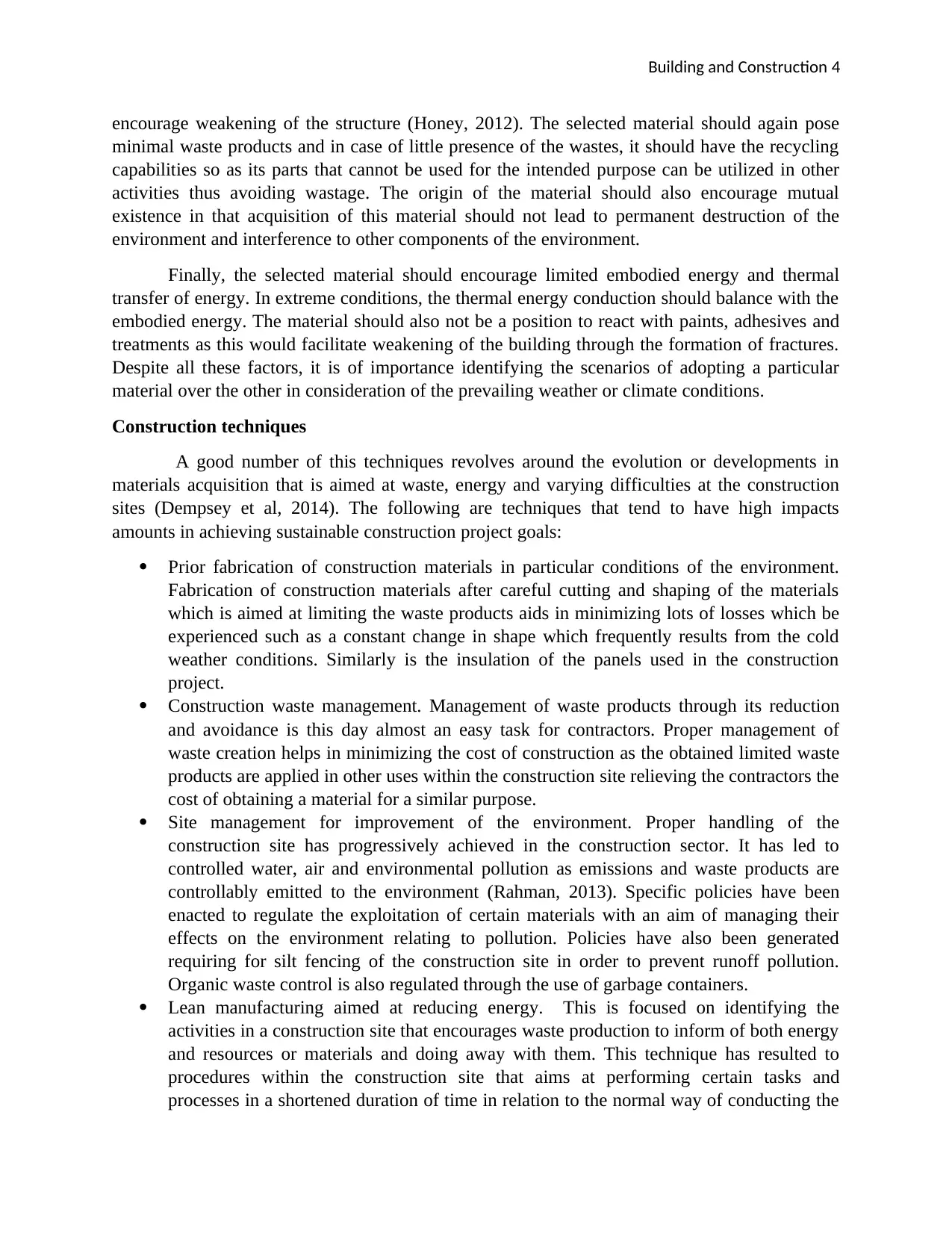
Building and Construction 4
encourage weakening of the structure (Honey, 2012). The selected material should again pose
minimal waste products and in case of little presence of the wastes, it should have the recycling
capabilities so as its parts that cannot be used for the intended purpose can be utilized in other
activities thus avoiding wastage. The origin of the material should also encourage mutual
existence in that acquisition of this material should not lead to permanent destruction of the
environment and interference to other components of the environment.
Finally, the selected material should encourage limited embodied energy and thermal
transfer of energy. In extreme conditions, the thermal energy conduction should balance with the
embodied energy. The material should also not be a position to react with paints, adhesives and
treatments as this would facilitate weakening of the building through the formation of fractures.
Despite all these factors, it is of importance identifying the scenarios of adopting a particular
material over the other in consideration of the prevailing weather or climate conditions.
Construction techniques
A good number of this techniques revolves around the evolution or developments in
materials acquisition that is aimed at waste, energy and varying difficulties at the construction
sites (Dempsey et al, 2014). The following are techniques that tend to have high impacts
amounts in achieving sustainable construction project goals:
Prior fabrication of construction materials in particular conditions of the environment.
Fabrication of construction materials after careful cutting and shaping of the materials
which is aimed at limiting the waste products aids in minimizing lots of losses which be
experienced such as a constant change in shape which frequently results from the cold
weather conditions. Similarly is the insulation of the panels used in the construction
project.
Construction waste management. Management of waste products through its reduction
and avoidance is this day almost an easy task for contractors. Proper management of
waste creation helps in minimizing the cost of construction as the obtained limited waste
products are applied in other uses within the construction site relieving the contractors the
cost of obtaining a material for a similar purpose.
Site management for improvement of the environment. Proper handling of the
construction site has progressively achieved in the construction sector. It has led to
controlled water, air and environmental pollution as emissions and waste products are
controllably emitted to the environment (Rahman, 2013). Specific policies have been
enacted to regulate the exploitation of certain materials with an aim of managing their
effects on the environment relating to pollution. Policies have also been generated
requiring for silt fencing of the construction site in order to prevent runoff pollution.
Organic waste control is also regulated through the use of garbage containers.
Lean manufacturing aimed at reducing energy. This is focused on identifying the
activities in a construction site that encourages waste production to inform of both energy
and resources or materials and doing away with them. This technique has resulted to
procedures within the construction site that aims at performing certain tasks and
processes in a shortened duration of time in relation to the normal way of conducting the
encourage weakening of the structure (Honey, 2012). The selected material should again pose
minimal waste products and in case of little presence of the wastes, it should have the recycling
capabilities so as its parts that cannot be used for the intended purpose can be utilized in other
activities thus avoiding wastage. The origin of the material should also encourage mutual
existence in that acquisition of this material should not lead to permanent destruction of the
environment and interference to other components of the environment.
Finally, the selected material should encourage limited embodied energy and thermal
transfer of energy. In extreme conditions, the thermal energy conduction should balance with the
embodied energy. The material should also not be a position to react with paints, adhesives and
treatments as this would facilitate weakening of the building through the formation of fractures.
Despite all these factors, it is of importance identifying the scenarios of adopting a particular
material over the other in consideration of the prevailing weather or climate conditions.
Construction techniques
A good number of this techniques revolves around the evolution or developments in
materials acquisition that is aimed at waste, energy and varying difficulties at the construction
sites (Dempsey et al, 2014). The following are techniques that tend to have high impacts
amounts in achieving sustainable construction project goals:
Prior fabrication of construction materials in particular conditions of the environment.
Fabrication of construction materials after careful cutting and shaping of the materials
which is aimed at limiting the waste products aids in minimizing lots of losses which be
experienced such as a constant change in shape which frequently results from the cold
weather conditions. Similarly is the insulation of the panels used in the construction
project.
Construction waste management. Management of waste products through its reduction
and avoidance is this day almost an easy task for contractors. Proper management of
waste creation helps in minimizing the cost of construction as the obtained limited waste
products are applied in other uses within the construction site relieving the contractors the
cost of obtaining a material for a similar purpose.
Site management for improvement of the environment. Proper handling of the
construction site has progressively achieved in the construction sector. It has led to
controlled water, air and environmental pollution as emissions and waste products are
controllably emitted to the environment (Rahman, 2013). Specific policies have been
enacted to regulate the exploitation of certain materials with an aim of managing their
effects on the environment relating to pollution. Policies have also been generated
requiring for silt fencing of the construction site in order to prevent runoff pollution.
Organic waste control is also regulated through the use of garbage containers.
Lean manufacturing aimed at reducing energy. This is focused on identifying the
activities in a construction site that encourages waste production to inform of both energy
and resources or materials and doing away with them. This technique has resulted to
procedures within the construction site that aims at performing certain tasks and
processes in a shortened duration of time in relation to the normal way of conducting the
Paraphrase This Document
Need a fresh take? Get an instant paraphrase of this document with our AI Paraphraser
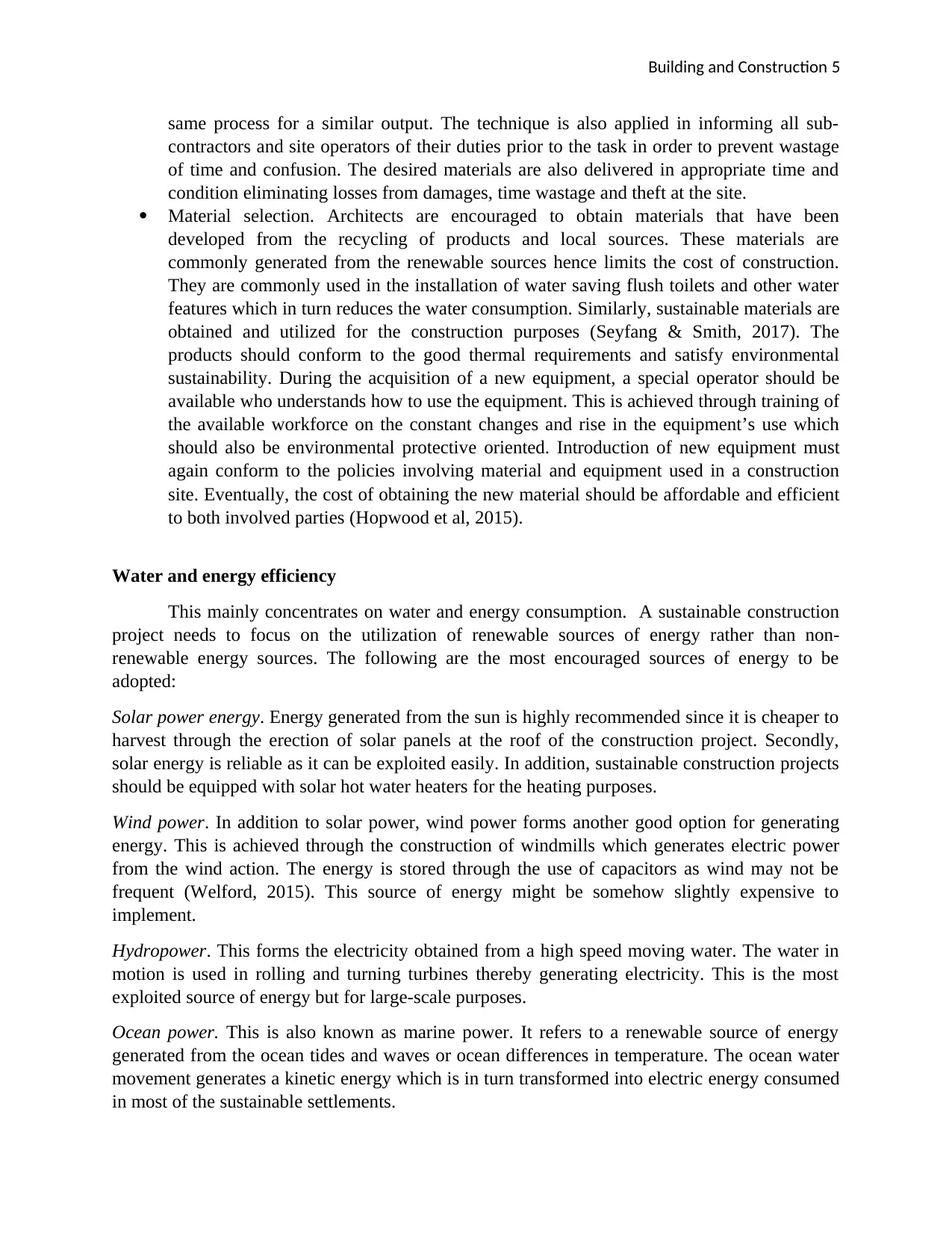
Building and Construction 5
same process for a similar output. The technique is also applied in informing all sub-
contractors and site operators of their duties prior to the task in order to prevent wastage
of time and confusion. The desired materials are also delivered in appropriate time and
condition eliminating losses from damages, time wastage and theft at the site.
Material selection. Architects are encouraged to obtain materials that have been
developed from the recycling of products and local sources. These materials are
commonly generated from the renewable sources hence limits the cost of construction.
They are commonly used in the installation of water saving flush toilets and other water
features which in turn reduces the water consumption. Similarly, sustainable materials are
obtained and utilized for the construction purposes (Seyfang & Smith, 2017). The
products should conform to the good thermal requirements and satisfy environmental
sustainability. During the acquisition of a new equipment, a special operator should be
available who understands how to use the equipment. This is achieved through training of
the available workforce on the constant changes and rise in the equipment’s use which
should also be environmental protective oriented. Introduction of new equipment must
again conform to the policies involving material and equipment used in a construction
site. Eventually, the cost of obtaining the new material should be affordable and efficient
to both involved parties (Hopwood et al, 2015).
Water and energy efficiency
This mainly concentrates on water and energy consumption. A sustainable construction
project needs to focus on the utilization of renewable sources of energy rather than non-
renewable energy sources. The following are the most encouraged sources of energy to be
adopted:
Solar power energy. Energy generated from the sun is highly recommended since it is cheaper to
harvest through the erection of solar panels at the roof of the construction project. Secondly,
solar energy is reliable as it can be exploited easily. In addition, sustainable construction projects
should be equipped with solar hot water heaters for the heating purposes.
Wind power. In addition to solar power, wind power forms another good option for generating
energy. This is achieved through the construction of windmills which generates electric power
from the wind action. The energy is stored through the use of capacitors as wind may not be
frequent (Welford, 2015). This source of energy might be somehow slightly expensive to
implement.
Hydropower. This forms the electricity obtained from a high speed moving water. The water in
motion is used in rolling and turning turbines thereby generating electricity. This is the most
exploited source of energy but for large-scale purposes.
Ocean power. This is also known as marine power. It refers to a renewable source of energy
generated from the ocean tides and waves or ocean differences in temperature. The ocean water
movement generates a kinetic energy which is in turn transformed into electric energy consumed
in most of the sustainable settlements.
same process for a similar output. The technique is also applied in informing all sub-
contractors and site operators of their duties prior to the task in order to prevent wastage
of time and confusion. The desired materials are also delivered in appropriate time and
condition eliminating losses from damages, time wastage and theft at the site.
Material selection. Architects are encouraged to obtain materials that have been
developed from the recycling of products and local sources. These materials are
commonly generated from the renewable sources hence limits the cost of construction.
They are commonly used in the installation of water saving flush toilets and other water
features which in turn reduces the water consumption. Similarly, sustainable materials are
obtained and utilized for the construction purposes (Seyfang & Smith, 2017). The
products should conform to the good thermal requirements and satisfy environmental
sustainability. During the acquisition of a new equipment, a special operator should be
available who understands how to use the equipment. This is achieved through training of
the available workforce on the constant changes and rise in the equipment’s use which
should also be environmental protective oriented. Introduction of new equipment must
again conform to the policies involving material and equipment used in a construction
site. Eventually, the cost of obtaining the new material should be affordable and efficient
to both involved parties (Hopwood et al, 2015).
Water and energy efficiency
This mainly concentrates on water and energy consumption. A sustainable construction
project needs to focus on the utilization of renewable sources of energy rather than non-
renewable energy sources. The following are the most encouraged sources of energy to be
adopted:
Solar power energy. Energy generated from the sun is highly recommended since it is cheaper to
harvest through the erection of solar panels at the roof of the construction project. Secondly,
solar energy is reliable as it can be exploited easily. In addition, sustainable construction projects
should be equipped with solar hot water heaters for the heating purposes.
Wind power. In addition to solar power, wind power forms another good option for generating
energy. This is achieved through the construction of windmills which generates electric power
from the wind action. The energy is stored through the use of capacitors as wind may not be
frequent (Welford, 2015). This source of energy might be somehow slightly expensive to
implement.
Hydropower. This forms the electricity obtained from a high speed moving water. The water in
motion is used in rolling and turning turbines thereby generating electricity. This is the most
exploited source of energy but for large-scale purposes.
Ocean power. This is also known as marine power. It refers to a renewable source of energy
generated from the ocean tides and waves or ocean differences in temperature. The ocean water
movement generates a kinetic energy which is in turn transformed into electric energy consumed
in most of the sustainable settlements.
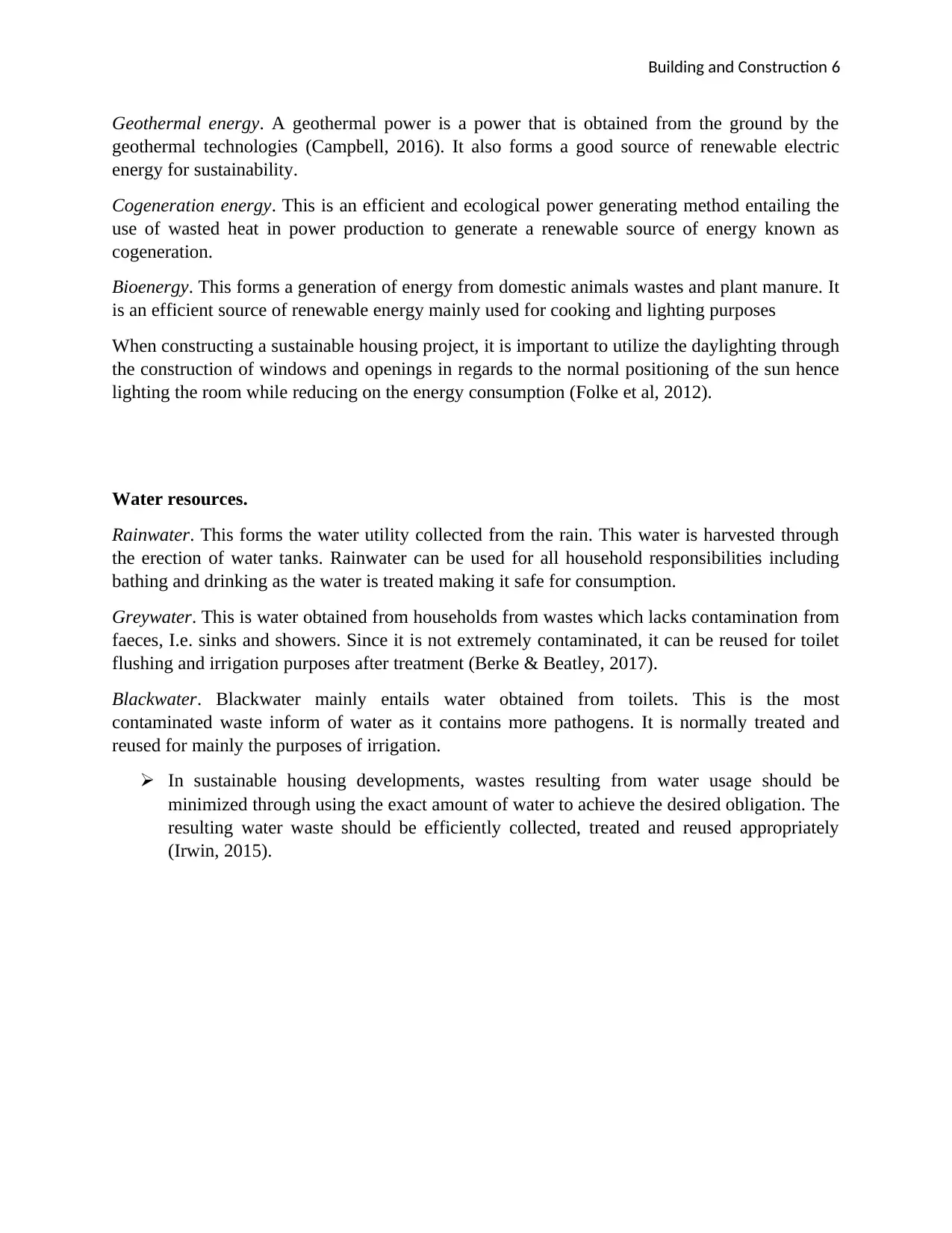
Building and Construction 6
Geothermal energy. A geothermal power is a power that is obtained from the ground by the
geothermal technologies (Campbell, 2016). It also forms a good source of renewable electric
energy for sustainability.
Cogeneration energy. This is an efficient and ecological power generating method entailing the
use of wasted heat in power production to generate a renewable source of energy known as
cogeneration.
Bioenergy. This forms a generation of energy from domestic animals wastes and plant manure. It
is an efficient source of renewable energy mainly used for cooking and lighting purposes
When constructing a sustainable housing project, it is important to utilize the daylighting through
the construction of windows and openings in regards to the normal positioning of the sun hence
lighting the room while reducing on the energy consumption (Folke et al, 2012).
Water resources.
Rainwater. This forms the water utility collected from the rain. This water is harvested through
the erection of water tanks. Rainwater can be used for all household responsibilities including
bathing and drinking as the water is treated making it safe for consumption.
Greywater. This is water obtained from households from wastes which lacks contamination from
faeces, I.e. sinks and showers. Since it is not extremely contaminated, it can be reused for toilet
flushing and irrigation purposes after treatment (Berke & Beatley, 2017).
Blackwater. Blackwater mainly entails water obtained from toilets. This is the most
contaminated waste inform of water as it contains more pathogens. It is normally treated and
reused for mainly the purposes of irrigation.
In sustainable housing developments, wastes resulting from water usage should be
minimized through using the exact amount of water to achieve the desired obligation. The
resulting water waste should be efficiently collected, treated and reused appropriately
(Irwin, 2015).
Geothermal energy. A geothermal power is a power that is obtained from the ground by the
geothermal technologies (Campbell, 2016). It also forms a good source of renewable electric
energy for sustainability.
Cogeneration energy. This is an efficient and ecological power generating method entailing the
use of wasted heat in power production to generate a renewable source of energy known as
cogeneration.
Bioenergy. This forms a generation of energy from domestic animals wastes and plant manure. It
is an efficient source of renewable energy mainly used for cooking and lighting purposes
When constructing a sustainable housing project, it is important to utilize the daylighting through
the construction of windows and openings in regards to the normal positioning of the sun hence
lighting the room while reducing on the energy consumption (Folke et al, 2012).
Water resources.
Rainwater. This forms the water utility collected from the rain. This water is harvested through
the erection of water tanks. Rainwater can be used for all household responsibilities including
bathing and drinking as the water is treated making it safe for consumption.
Greywater. This is water obtained from households from wastes which lacks contamination from
faeces, I.e. sinks and showers. Since it is not extremely contaminated, it can be reused for toilet
flushing and irrigation purposes after treatment (Berke & Beatley, 2017).
Blackwater. Blackwater mainly entails water obtained from toilets. This is the most
contaminated waste inform of water as it contains more pathogens. It is normally treated and
reused for mainly the purposes of irrigation.
In sustainable housing developments, wastes resulting from water usage should be
minimized through using the exact amount of water to achieve the desired obligation. The
resulting water waste should be efficiently collected, treated and reused appropriately
(Irwin, 2015).
⊘ This is a preview!⊘
Do you want full access?
Subscribe today to unlock all pages.

Trusted by 1+ million students worldwide
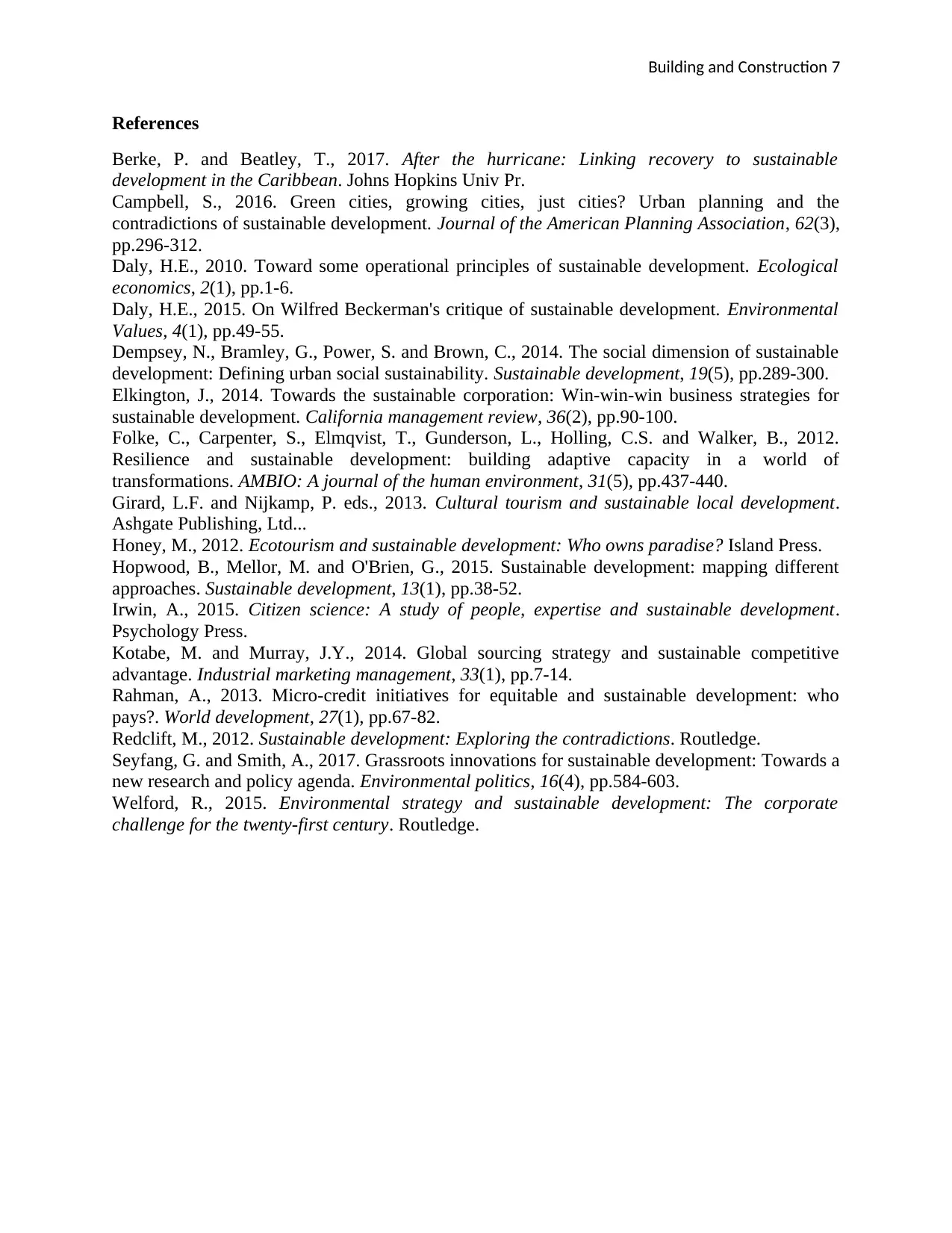
Building and Construction 7
References
Berke, P. and Beatley, T., 2017. After the hurricane: Linking recovery to sustainable
development in the Caribbean. Johns Hopkins Univ Pr.
Campbell, S., 2016. Green cities, growing cities, just cities? Urban planning and the
contradictions of sustainable development. Journal of the American Planning Association, 62(3),
pp.296-312.
Daly, H.E., 2010. Toward some operational principles of sustainable development. Ecological
economics, 2(1), pp.1-6.
Daly, H.E., 2015. On Wilfred Beckerman's critique of sustainable development. Environmental
Values, 4(1), pp.49-55.
Dempsey, N., Bramley, G., Power, S. and Brown, C., 2014. The social dimension of sustainable
development: Defining urban social sustainability. Sustainable development, 19(5), pp.289-300.
Elkington, J., 2014. Towards the sustainable corporation: Win-win-win business strategies for
sustainable development. California management review, 36(2), pp.90-100.
Folke, C., Carpenter, S., Elmqvist, T., Gunderson, L., Holling, C.S. and Walker, B., 2012.
Resilience and sustainable development: building adaptive capacity in a world of
transformations. AMBIO: A journal of the human environment, 31(5), pp.437-440.
Girard, L.F. and Nijkamp, P. eds., 2013. Cultural tourism and sustainable local development.
Ashgate Publishing, Ltd...
Honey, M., 2012. Ecotourism and sustainable development: Who owns paradise? Island Press.
Hopwood, B., Mellor, M. and O'Brien, G., 2015. Sustainable development: mapping different
approaches. Sustainable development, 13(1), pp.38-52.
Irwin, A., 2015. Citizen science: A study of people, expertise and sustainable development.
Psychology Press.
Kotabe, M. and Murray, J.Y., 2014. Global sourcing strategy and sustainable competitive
advantage. Industrial marketing management, 33(1), pp.7-14.
Rahman, A., 2013. Micro-credit initiatives for equitable and sustainable development: who
pays?. World development, 27(1), pp.67-82.
Redclift, M., 2012. Sustainable development: Exploring the contradictions. Routledge.
Seyfang, G. and Smith, A., 2017. Grassroots innovations for sustainable development: Towards a
new research and policy agenda. Environmental politics, 16(4), pp.584-603.
Welford, R., 2015. Environmental strategy and sustainable development: The corporate
challenge for the twenty-first century. Routledge.
References
Berke, P. and Beatley, T., 2017. After the hurricane: Linking recovery to sustainable
development in the Caribbean. Johns Hopkins Univ Pr.
Campbell, S., 2016. Green cities, growing cities, just cities? Urban planning and the
contradictions of sustainable development. Journal of the American Planning Association, 62(3),
pp.296-312.
Daly, H.E., 2010. Toward some operational principles of sustainable development. Ecological
economics, 2(1), pp.1-6.
Daly, H.E., 2015. On Wilfred Beckerman's critique of sustainable development. Environmental
Values, 4(1), pp.49-55.
Dempsey, N., Bramley, G., Power, S. and Brown, C., 2014. The social dimension of sustainable
development: Defining urban social sustainability. Sustainable development, 19(5), pp.289-300.
Elkington, J., 2014. Towards the sustainable corporation: Win-win-win business strategies for
sustainable development. California management review, 36(2), pp.90-100.
Folke, C., Carpenter, S., Elmqvist, T., Gunderson, L., Holling, C.S. and Walker, B., 2012.
Resilience and sustainable development: building adaptive capacity in a world of
transformations. AMBIO: A journal of the human environment, 31(5), pp.437-440.
Girard, L.F. and Nijkamp, P. eds., 2013. Cultural tourism and sustainable local development.
Ashgate Publishing, Ltd...
Honey, M., 2012. Ecotourism and sustainable development: Who owns paradise? Island Press.
Hopwood, B., Mellor, M. and O'Brien, G., 2015. Sustainable development: mapping different
approaches. Sustainable development, 13(1), pp.38-52.
Irwin, A., 2015. Citizen science: A study of people, expertise and sustainable development.
Psychology Press.
Kotabe, M. and Murray, J.Y., 2014. Global sourcing strategy and sustainable competitive
advantage. Industrial marketing management, 33(1), pp.7-14.
Rahman, A., 2013. Micro-credit initiatives for equitable and sustainable development: who
pays?. World development, 27(1), pp.67-82.
Redclift, M., 2012. Sustainable development: Exploring the contradictions. Routledge.
Seyfang, G. and Smith, A., 2017. Grassroots innovations for sustainable development: Towards a
new research and policy agenda. Environmental politics, 16(4), pp.584-603.
Welford, R., 2015. Environmental strategy and sustainable development: The corporate
challenge for the twenty-first century. Routledge.
1 out of 7
Your All-in-One AI-Powered Toolkit for Academic Success.
+13062052269
info@desklib.com
Available 24*7 on WhatsApp / Email
![[object Object]](/_next/static/media/star-bottom.7253800d.svg)
Unlock your academic potential
Copyright © 2020–2025 A2Z Services. All Rights Reserved. Developed and managed by ZUCOL.